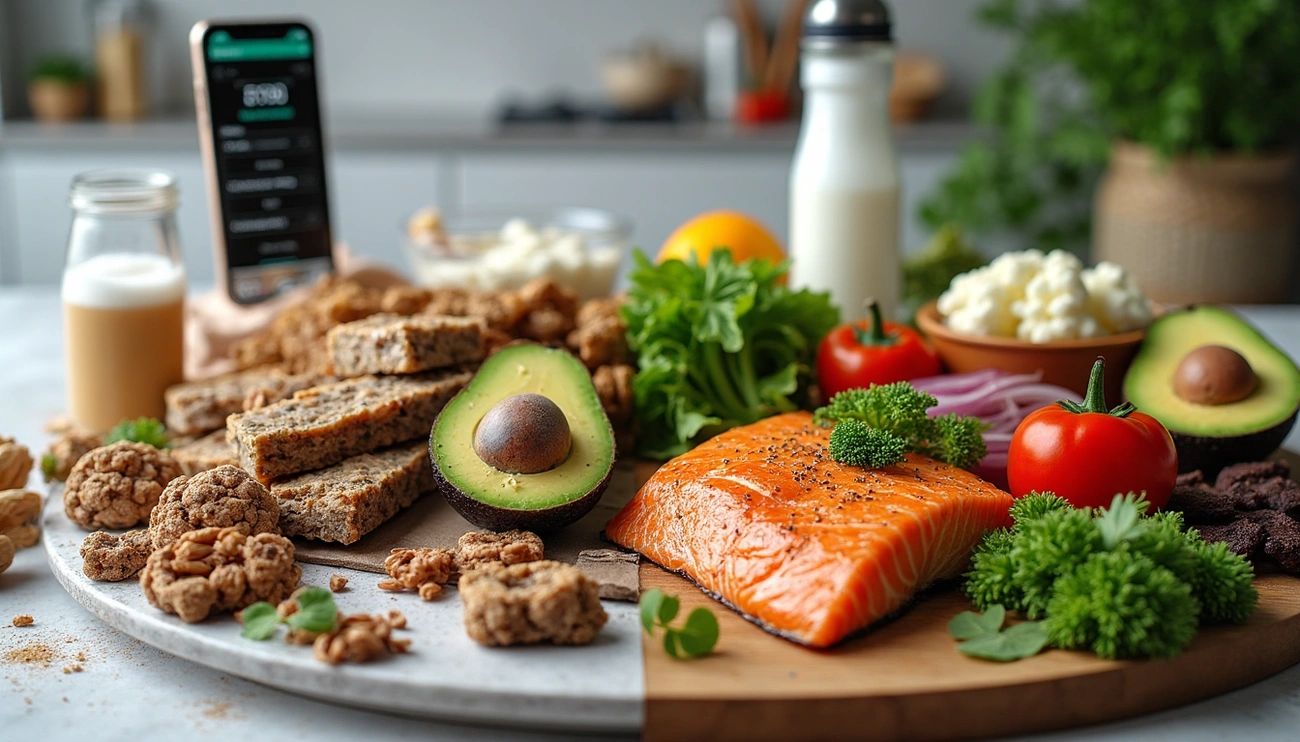Started keto and gained weight instead of losing it. Not what I expected.
One day I’m eating cereal and sandwiches. Next day I’m trying to stay under 50 grams of carbs. Big change. Too big, actually.
I did everything wrong. The scale went up instead of down. Hidden carbs in my sauces. Wrong macro ratios. Electrolyte problems. Pretty frustrating.
Took me weeks to figure out what was happening. Finally decided to research my mistakes.
Over 30 days, I found eight critical errors. Fixed them one by one. If you’re gaining weight on keto like I was, you might be making these same mistakes. Good news is they’re fixable.
The First Week: Rushing Into Keto Without a Plan
Biggest mistake was jumping in without a plan. Got excited about weight loss and made poor decisions.
Why I jumped in too fast
Wanted rapid results. Switched from high-carb eating to under 50 grams daily. One baked potato and a slice of bread equals your entire day’s carbs. That’s how dramatic the change is.
I didn’t calculate my macros. Didn’t prep my kitchen. Didn’t research what keto actually requires – 70-80% of calories from fat. Just decided one day to start. Bad approach.
This isn’t like other diets. Keto demands precision. Most people eat high-carb processed foods, so the switch is massive. I underestimated how regimented it would be.
How cutting carbs overnight backfired
Day two hit me hard. Headaches, dizziness, fatigue, crazy cravings. Later learned this was “keto flu” – your body protesting the carb withdrawal.
Takes about 72 hours for ketosis to start. Your brain switches from glucose to ketones for fuel. Body dumps water as carb stores deplete. Creates electrolyte imbalances with sodium, potassium, and magnesium.
Worst part? Gained two pounds that first week. Completely demoralized me.
What I should have done instead
Gradual approach works better. Start with one keto meal daily for several days. Add a second meal. Then go full keto after your body adjusts.
Should have prepared first:
- Calculate personal macros with a keto calculator
- Stock keto foods, remove temptations
- Plan meals in advance
- Pick a less stressful start time
I would increase water and salt intake before starting. Add electrolyte supplements. Begin with regular low-carb first to teach your body to burn fat. Much smoother transition that way.
Mistake 1 & 2: Misjudging Macros and Eating Too Many Carbs
Week one, zero weight loss. My macro approach was completely wrong. Scale wasn’t moving, energy was terrible.
Not calculating my keto macros correctly
Thought keto was just cutting carbs. Wrong. The balance is precise: 70-80% fat, 20-30% protein, only 5-10% carbs. This balance matters for ketosis.
I didn’t calculate my personal macros. Everyone’s different based on weight goals, activity level, metabolism. I was guessing at everything.
Also misunderstood “high fat.” Loaded up on cream and butter while skipping protein. Bad move. Needed adequate protein for muscle mass.
Used a macro calculator to get my specific numbers. Game changer. These calculators factor in your goals and recommend the right calorie targets.
Hidden carbs that kicked me out of ketosis
Fixed my macros but still couldn’t get into ketosis. Hidden carbs everywhere. Need to stay under 20-50 grams net carbs daily. These sneaky carbs kept pushing me over.
Condiments killed me. One tablespoon of ketchup has 4 grams of carbs. Garlic powder packs 6 grams per tablespoon. Seasonings like cumin (2.75g), onion powder (5.4g), chili powder (4.1g) added up fast.
“Sugar-free” doesn’t mean carb-free. Many contain dextrose and maltodextrin. Some sugar alcohols like maltitol spike blood sugar despite being marketed as keto-friendly.
Even shellfish have carbs. One large oyster has about 6 grams from glycogen. My seafood dinners were sabotaging me.
How I learned to track carbs the right way
Tracking became essential. Learned to calculate net carbs by subtracting fiber from total carbs. Example: 25 grams carbs minus 7 grams fiber equals 18 net carbs.
Tried different apps:
- Cronometer tracks micronutrients well, lets you set net carb targets
- Carb Manager has photo recognition
- MyFitnessPal huge database but you calculate net carbs manually
Food journaling showed my portion problems. Manufacturers use tiny serving sizes to make products look healthier. Tracking taught me proper portions.
Started reading labels carefully. Looked past “keto” claims to actual nutrition facts. Found tons of “ninja carbs” – items labeled zero carbs that actually had significant amounts.
These changes fixed everything. Finally got into ketosis and started burning fat.
Mistake 3 & 4: Too Much Protein, Not Enough Fat
Image Source: Low Carb Yum
Got my macros completely backwards. Too much protein, not enough fat.
After tracking for a week, the pattern was clear. I was eating like it was a high-protein diet instead of keto. Big mistake.
Why too much protein can be a problem
Protein on keto should be moderate. Not excessive like I was doing. The ketogenic diet needs enough protein to preserve muscle, but too much prevents ketosis.
Here’s what happens – your body converts excess protein into glucose through gluconeogenesis. Basically, your body turns extra protein into sugar, which raises insulin and stops ketone production. For people with insulin resistance, this is even worse.
Standard keto is around 55-60% fat, 30-35% protein, 5-10% carbs. I was eating 45% protein and only 50% fat. Way off.
My breath sometimes smelled like ammonia. That’s a sign you’re eating too much protein.
How I misunderstood ‘high fat’
I thought “high fat” meant adding a little butter to my meals. Wrong.
On keto, fat should be 60-80% of your calories. For 2000 calories, that’s 133-178 grams of fat. Seemed impossible at first. Fat has 9 calories per gram versus protein’s 4 calories per gram.
My meals looked nothing like proper keto. I’d eat large chicken breasts with barely any added fat. A proper keto meal should be about half protein, half fat by weight.
I thought more protein would speed up weight loss. Actually, overeating any macronutrient causes weight gain. Plus, focusing on protein meant I wasn’t getting enough fat for ketosis.
Fixing my fat-to-protein ratio for better results
Had to deliberately increase fat while cutting protein. Calculated my protein needs – about 0.7 to 0.9 grams per pound of body weight. Enough for muscle maintenance without interfering with ketosis.
I added these strategies:
- Put butter or coconut oil in coffee and tea
- Used vegetables as vehicles for high-fat dressings
- Made fat bombs with coconut or nut butter
- Chose fattier meat cuts and kept chicken skin
- Ate more salmon instead of white fish
- Kept olives, boiled eggs, and avocados handy
Focused on healthier fats too. Avocados, olive oil, nuts, fatty fish instead of processed meats. Better nutrition plus ketosis support.
Monitored my ketone levels throughout the adjustment. Within two weeks of fixing this balance, the scale finally started moving down. This protein-fat ratio really matters for keto success.
Mistake 5 & 6: Ignoring Electrolytes and Skipping Veggies
Image Source: Curaprox
Two more problems I completely missed. Electrolytes and vegetables. Thought I could skip both and still succeed.
Keto and sodium: how much salt on keto?
Turns out keto needs way more salt than normal eating. We’re talking 3000-5000mg of sodium daily. Regular recommendations are only 2300mg. Big difference.
Why the jump? Low-carb diets lower insulin, which makes your kidneys dump sodium. Your body basically flushes out water and electrolytes, especially the first few weeks.
I started adding 2 grams of sodium daily through broth. Also used salted butter and bacon to hit my targets. Felt weird adding salt to everything when we’re usually told to avoid it. But without enough sodium on keto, you get brain fog, fatigue, and restlessness.
The signs of electrolyte imbalance I missed
My headaches weren’t “keto adaptation.” Neither were the muscle cramps at night or the constant tiredness. My body needed electrolytes.
Sodium’s just one piece. Also need:
- Potassium: Stops muscle cramps, balances sodium
- Magnesium: Helps nerves and energy, prevents leg cramps
- Calcium: For muscles and bones
The constipation was the worst part. Electrolytes control how your colon works. Without them, everything slows down.
Why fiber and veggies matter more than I thought
Biggest mistake was thinking I could do keto without vegetables. Wrong. Vegetables are the foundation. Should get 12-15g net carbs from veggies daily.
Best choices grow above ground. Root vegetables have too much starch. I focused on spinach (1g net carbs per 100g), asparagus (2g), avocado (2g), cauliflower (3g), and broccoli (4g).
Skipping vegetables meant no fiber. Fiber keeps your digestive system moving. Once I added more low-carb vegetables, the constipation problem disappeared.
Added electrolyte supplements and ate more vegetables. Finally started losing weight. Small changes, big results.
Mistake 7 & 8: Snacking Too Much and Ignoring Stress
Week three. Still not seeing the results I wanted. Fixed my macros, balanced fat and protein, sorted electrolytes. But two more problems were sabotaging me.
Mindless Snacking Stalled My Progress
Perfect macros didn’t matter when I kept grazing all day. Nuts, cheese, fat bombs – all keto-approved, but I was eating way too much. These foods pack serious calories.
One extra ounce of nuts daily adds thousands of calories monthly. That’s a lot. I was snacking on “healthy” keto foods without tracking portions. Big mistake.
Started limiting my snacking sessions. When truly hungry, I switched to non-starchy vegetables with protein. Much better for staying within calorie limits.
Overlooking Stress and Physical Activity
I focused only on food. Ignored everything else affecting my weight loss. Chronic stress produces cortisol – the hormone that makes you store fat, especially around your belly.
Stress also messed up my sleep. Bad sleep made cravings stronger and willpower weaker. Vicious cycle.
My sedentary lifestyle wasn’t helping either. Exercise builds muscle, which boosts your metabolic rate. I started with daily walks, then added strength training twice weekly. Moderate approach worked better than going overboard.
Made these changes and weight loss resumed immediately. Keto isn’t just about counting carbs. You need the whole lifestyle approach – mindful eating, stress management, regular movement.
FAQs
Q1. What are the most common mistakes people make when starting a keto diet?
Common mistakes include not calculating macros correctly, consuming hidden carbs, eating too much protein and not enough fat, ignoring electrolytes, and skipping vegetables. It’s important to plan carefully and track your intake to avoid these pitfalls.
Q2. How can I increase my fat intake on a keto diet without overdoing calories?
You can increase healthy fat intake by adding fats to hot drinks, using vegetables as vehicles for high-fat dressings, creating fat bombs, choosing fattier cuts of meat, incorporating fatty fish, and keeping high-fat snacks like avocados and nuts accessible. Focus on nutrient-dense sources of fat.
Q3. Why is electrolyte balance important on a ketogenic diet?
Electrolyte balance is crucial because a low-carb diet lowers insulin levels, causing increased sodium excretion. This can lead to symptoms like headaches, muscle cramps, and fatigue. Increasing sodium intake and ensuring adequate potassium, magnesium, and calcium can help prevent these issues.
Q4. Can eating too much protein kick you out of ketosis?
Yes, consuming excessive protein can potentially kick you out of ketosis. This is because the body can convert excess protein into glucose through a process called gluconeogenesis, which may raise insulin levels and inhibit ketone production. It’s important to maintain a proper balance of macronutrients.
Q5. How can I overcome weight loss plateaus on a keto diet?
To overcome plateaus, reassess your macros, be mindful of snacking on calorie-dense foods, manage stress levels, incorporate regular physical activity, and ensure you’re getting enough sleep. Sometimes, small adjustments in these areas can restart weight loss progress.

